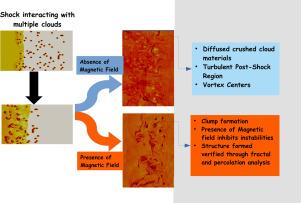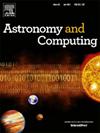Effects of magnetic fields on the formation of Interstellar Filaments through shock-cloud interaction
IF 1.8
4区 物理与天体物理
Q2 ASTRONOMY & ASTROPHYSICS
引用次数: 0
Abstract
Interstellar Filaments are ubiquitous in molecular clouds which are hotbeds for star birth. What leads to their formation has been a subject of study in recent years. In the present numerical experiment, we have looked into the role of magnetic field in formation of such structures in the context of multiple molecular cloud complexes after they were subjected to a passing shock. We found that in the absence of this field, post-shock region is turbulent, leading to higher material mixing, 17.5% in the case of the highest porous model considered which also had 42% higher area filling factor compared to models with magnetic field imposed. On the other hand in the presence of a magnetic field, processes such as ‘mass-loading’, slowing down of shock, and inhibition of instabilities are observed which we have found to facilitate the formation of less porous and hence more clumpy structures in post-shock regions. It is found that in the absence of a field, such structures are diffused and spread over a larger area. Such structures are later elongated by hydrodynamical ablation leading to filament-like structures. Morphological output images having filamentary structures are further studied using tools from Nonlinear Dynamics such as Percolation and Fractal Analysis. We find that the filaments formed without a field have higher fractal dimensions, are longer, more complex, and highly branched. Magnetic field influences the properties of the filaments, making them smaller, more confined, and less complex. Further, it is observed that the influence of B is diminished with the presence of radiative cooling, still having a subtle affect on the system’s evolution though.

磁场通过冲击云相互作用对星际纤丝形成的影响
星际细丝在分子云中无处不在,而分子云是恒星诞生的温床。它们的形成原因一直是近年来的研究课题。在目前的数值实验中,我们研究了磁场在多个分子云复合体受到冲击后形成此类结构的过程中的作用。我们发现,在没有磁场的情况下,冲击后区域是湍流的,导致更高的物质混合,在最高多孔模型的情况下为 17.5%,与施加磁场的模型相比,其面积填充因子也高出 42%。另一方面,在存在磁场的情况下,我们观察到了 "质量加载"、减慢冲击速度和抑制不稳定性等过程,我们发现这些过程有利于在冲击后区域形成较少的多孔结构,从而形成更多的团块结构。我们发现,在没有磁场的情况下,这种结构会扩散到更大的区域。这些结构随后会被流体动力烧蚀拉长,形成丝状结构。我们使用非线性动力学工具(如渗透和分形分析)对具有丝状结构的形态输出图像进行了进一步研究。我们发现,在没有磁场的情况下形成的丝状结构具有更高的分形维度、更长、更复杂和高度分枝。磁场会影响丝状体的特性,使其变得更小、更封闭、更复杂。此外,我们还观察到,B 的影响会随着辐射冷却的存在而减弱,但仍会对系统的演化产生微妙的影响。
本文章由计算机程序翻译,如有差异,请以英文原文为准。
求助全文
约1分钟内获得全文
求助全文
来源期刊

Astronomy and Computing
ASTRONOMY & ASTROPHYSICSCOMPUTER SCIENCE,-COMPUTER SCIENCE, INTERDISCIPLINARY APPLICATIONS
CiteScore
4.10
自引率
8.00%
发文量
67
期刊介绍:
Astronomy and Computing is a peer-reviewed journal that focuses on the broad area between astronomy, computer science and information technology. The journal aims to publish the work of scientists and (software) engineers in all aspects of astronomical computing, including the collection, analysis, reduction, visualisation, preservation and dissemination of data, and the development of astronomical software and simulations. The journal covers applications for academic computer science techniques to astronomy, as well as novel applications of information technologies within astronomy.
 求助内容:
求助内容: 应助结果提醒方式:
应助结果提醒方式:


